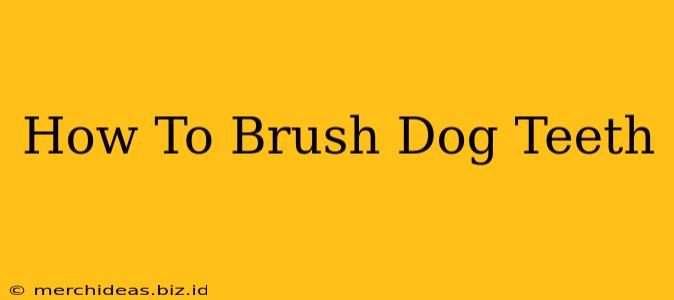Keeping your canine companion healthy involves more than just food and walks. Regular dental care is crucial for preventing painful and costly problems down the line. This comprehensive guide will walk you through how to brush your dog's teeth effectively and safely, making it a positive experience for both you and your furry friend.
Why is Brushing Your Dog's Teeth Important?
Dental disease is incredibly common in dogs. Untreated, it can lead to:
- Gum disease (gingivitis and periodontitis): Inflammation and infection of the gums, potentially leading to tooth loss.
- Bad breath (halitosis): A telltale sign of underlying dental problems.
- Tooth decay and abscesses: Painful infections that can spread throughout the body.
- Heart and kidney disease: Bacteria from infected gums can enter the bloodstream and affect other organs.
Regular brushing is your first line of defense against these serious health issues.
Getting Started: Gathering Your Supplies
Before you begin, you'll need the right tools:
- Dog-specific toothpaste: Human toothpaste is toxic to dogs. Look for enzymatic toothpaste formulated for canine use, available at pet stores. Avoid fluoride toothpaste designed for humans.
- Dog toothbrush: Choose a toothbrush designed for dogs. These are typically smaller and softer than human toothbrushes, with a variety of shapes and sizes available to fit your dog's mouth. Finger brushes are a great option for puppies or dogs who are new to teeth brushing.
- Towels: You'll likely need a few towels to keep your dog and your surroundings clean.
Introducing Your Dog to Toothbrushing: A Step-by-Step Approach
The key to successful teeth brushing is positive reinforcement and gradual introduction. Don't rush the process.
Step 1: The Get-Acquainted Phase
- Start by letting your dog sniff and investigate the toothbrush and toothpaste.
- Reward them with treats and praise.
- Gently touch their lips and gums with your finger. Reward them for allowing this.
- Gradually work your way to lifting their lips and briefly touching their teeth.
Step 2: The Taste Test
- Let your dog lick a small amount of toothpaste from your finger. Most dogs find the flavors appealing.
Step 3: The Initial Brushing
- Apply a small amount of toothpaste to the toothbrush.
- Start by brushing the outer surfaces of the teeth, using gentle, circular motions.
- Only brush for a few seconds initially. Don't force it!
- Reward your dog generously with treats and praise.
Step 4: Gradual Increase in Brushing Time
- Gradually increase the brushing time over several sessions. Aim for at least 2 minutes, twice a day, if possible.
- Gradually introduce brushing the inner surfaces of the teeth.
Tips for Success
- Make it a routine: Establish a consistent brushing schedule to make it a habit.
- Be patient: It takes time for some dogs to get used to toothbrushing.
- Positive reinforcement is key: Use treats, praise, and toys to reward good behavior.
- Consider dental chews: While not a replacement for brushing, dental chews can help remove plaque and tartar.
- Regular vet checkups: Schedule regular veterinary checkups to monitor your dog's dental health.
Dealing with Resistance
If your dog resists toothbrushing, don't give up. Try these strategies:
- Start with shorter sessions: If they get anxious, shorten the brushing time.
- Use different techniques: Try a finger brush or a different type of toothbrush.
- Desensitization: Work on getting your dog comfortable with having their mouth touched before introducing the toothbrush.
- Consult your veterinarian: They can offer advice and may recommend dental cleaning under anesthesia if needed.
Brushing your dog's teeth is an essential part of preventative care. By following these steps and remaining patient, you'll be well on your way to ensuring your dog enjoys a long and healthy life with a bright, clean smile.
